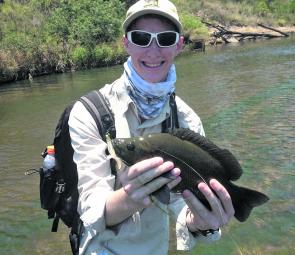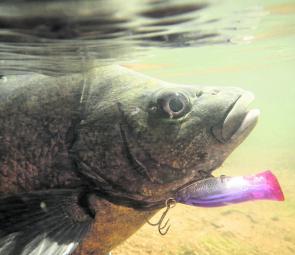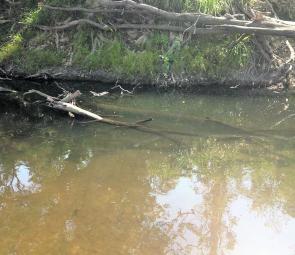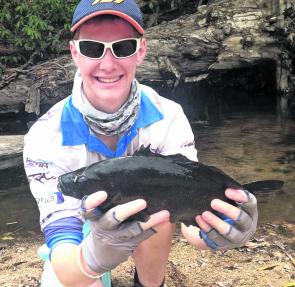In North Queensland we are blessed to have both freshwater and saltwater fishing right at our doorstep. One species in particular that I’ve been targeting lately has been the humble sooty grunter. These fish have a limited distribution, being found only in coastal and inland freshwater streams and rivers of NQ, NT and some parts of WA.
These tough Aussie natives can adapt to fast-changing conditions such as flash flooding and severe drought. They prefer streams and rivers that have good oxygen content and fast flowing water for most of the year.
They can be caught throughout the year but their feeding patterns often change. This is great for anglers, particularly during the summer months when the sooties begin to congregate in large schools to breed. Spawning is triggered by rising water levels combined with water temperatures exceeding around 25°C.
Sooty grunter are an opportunistic feeding fish which makes them a very exiting species for anglers to target. Due to their aggressive nature sooty grunter will take a large selection of lures, flies and bait fished in amongst large snags or deep holes.
Not all rivers and creeks in north Queensland have populations of sooty grunter. The best tool in finding likely looking areas is to use the internet and do a bit of research!
There are well known sooty locations in big river systems, but these areas are often heavily fished. Instead of fishing these areas yourself, just look them up on Google Earth and have a look for smaller creeks and streams running into that main system. This is often where the best fishing is. You may just find your very own secret spot where no one else fishes that has a very large population of sooty grunter!
Sooty grunter are very opportunistic and will take almost anything small that is thrown at them. My favourite lures vary according to the time of day and the amount of shade covering the water.
I find the most exciting and heart-racing technique is to use small poppers or fizzers. Lately I’ve had a lot of success on the 45mm Halco Roosta popper which is a perfect little surface lure for early morning and low light conditions. Sooty grunter rarely venture far past protected cover, so surface fishing is difficult without good cloud cover creating shadow over the snag or ambush point.
When the surface action slows down I opt for a sinking soft plastic. My favourite is the Berkley Ripple Shad fished slowly amongst the snags on a light jighead.
Getting your technique right can mean the difference between catching 40 fish a session or just a handful. Sooty grunter are an ambush feeder which means they sit close under cover waiting for food to come to them. For that reason you need to fish as close to the snags as possible and be ready to get stuck into the fish as soon as your lure hits the water. A small deepwater snag can hold 20 or more fish, and the moment your lure hits the water they can be all over it.
Don’t underestimate how hard a 40cm sooty can pull! It will drill you into the snags the instant it hits the lure if you let it. I fish a fairly tight drag and use my hand on the spool to steer their head if needed.
For luring the streams for sooty grunter I opt for lightweight gear. A 2-4kg rod is ideal. Match it with a 2500 size reel with 8lb braid and a 12-15lb leader and you’re ready for a epic session on the water.
One final thing I have to mention is the danger involved with fishing the creeks and rivers of North Queensland. The biggest killer or session ender of an angler is dehydration and heatstroke. Walking long distances in the heat is often required to catch these hard-to-find fish and you must be prepared for such conditions. Always bring plenty of water (a bottle of Powerade helps as well) to keep your body’s salt levels up, reducing chance of cramps.
When it comes to clothing, wear the lightest and coolest sun protective clothing you have. If possible, bring along a GPS as well.
Another hazard comes from the dangerous animals that also share these pristine waterways. Saltwater crocodiles love big, open freshwater systems, especially where there is cattle access from surrounding farms. Big crocs are found throughout most large freshwater systems and it is a real risk if you don't take general precautions. Limit your time wading the water as much as you can and don't wade more than knee height at all times. If the water isn’t clear, stay out altogether. You also need to keep an eye out for croc slides surrounding your standing location.
Snakes can also be found in these areas, and in the warmer months the risk of bites increases dramatically. Stick to flat terrain and avoid long grass and you should be right.
The most important safety tip I can give you, however, is to bring someone along and have a first-aid kit in your backpack. In the unlikely event that something bad happens, he might just save your life.
All of this preparation is easily worth the trouble because the rewards are so great. Sooty grunter are a magical species to target in our pristine freshwater systems of the north! They are fun, exciting and the memories and photos of an epic session are well worth that long walk you made.
Good luck and stay safe on the water.
Facts
Sooty stats
Also called ‘black bream’, this aggressive, territorial fish has a stocky body and ranges in colour from solid black to brownish grey/tan.
Sooty grunter are found in large streams, either clear or turbid, which have a reasonable flow. The preferred areas are the upper stretches in areas with a sandy or rocky bottom and a small amount of aquatic plant growth. These fish can tolerate a wide range of temperatures (between 12-34ºC) and their main diet consists of insects, frogs, worms, crustaceans and berries.
Spawning is triggered in summer in response to higher water levels from the wet season rains.
Sooty grunter can grow up to 45cm (4kg) but the most common size encountered is around 25cm. The minimum legal size in Queensland is 28cm and the bag limit is 10 (combined sooty grunter and khaki grunter).
Sooty grunter are an acceptable tablefish, although most anglers view their fighting qualities as better than their eating qualities.

Not all fish are taken from structure. This fish was spotted cruising open sand flats and took a well presented soft plastic cast towards it.

Sooty grunter love poppers and hit them hard! This fish ate a Halco Roosta popper as it landed.

Sooty heaven! A snag like this is almost guaranteed to hold plenty of fish. Nearly a dozen fish were caught from this one log jam.

This fish took Powerbait T-tail minnow the second it hit the water. Note the fallen log he was caught from in the background.

A beautifully conditioned sooty grunter. Fish of this size and larger can really pull some drag!




